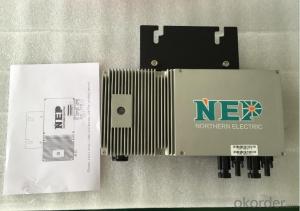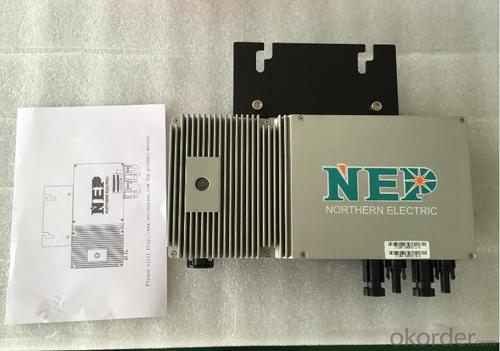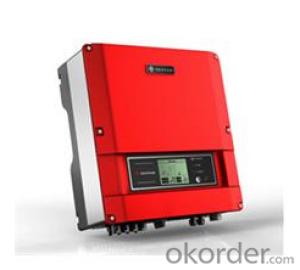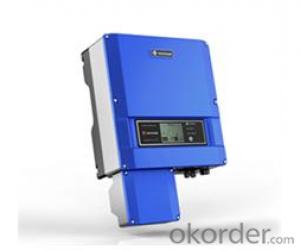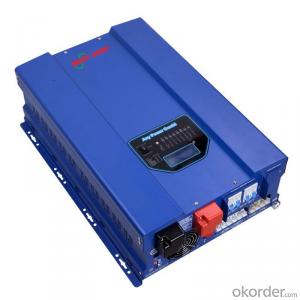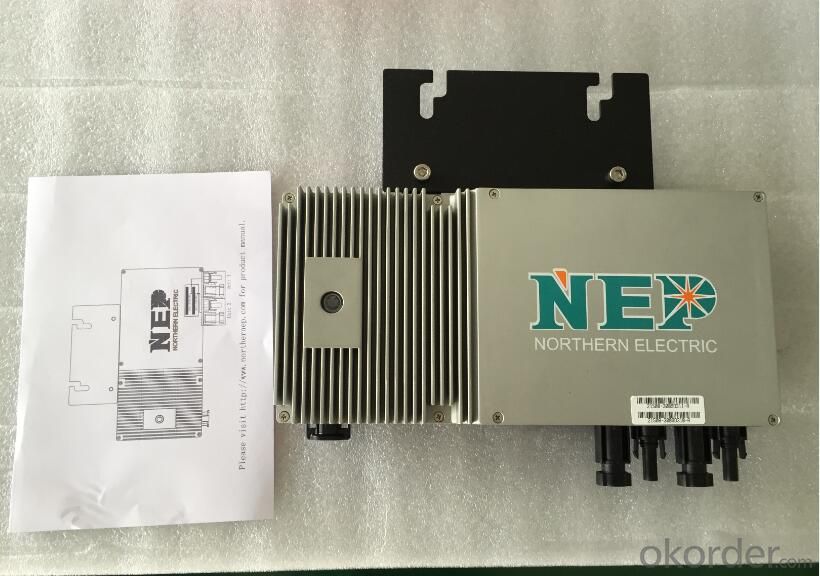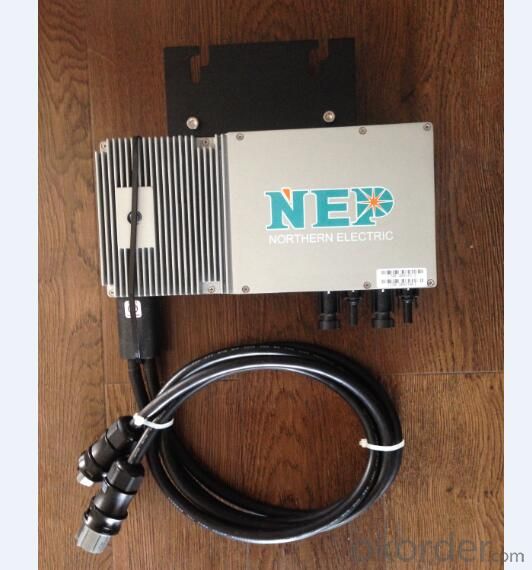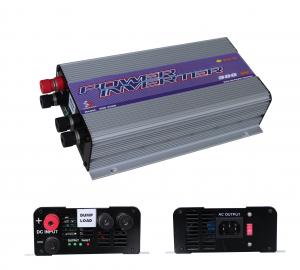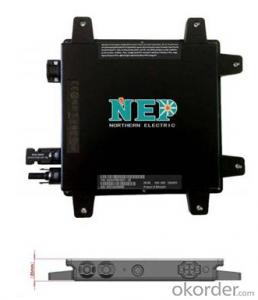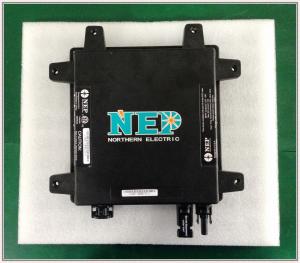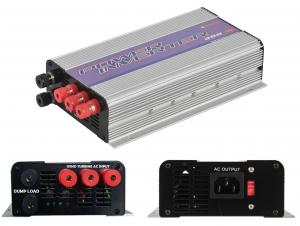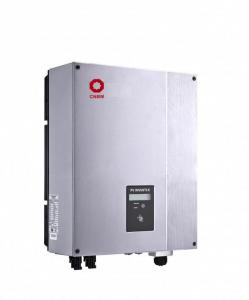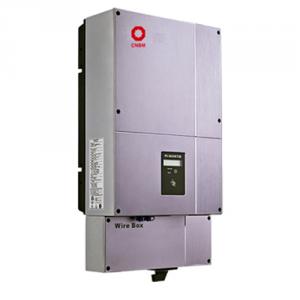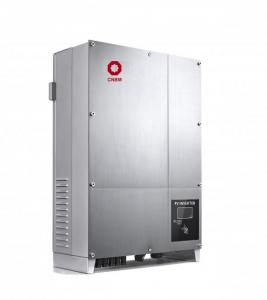High efficiency ON grid tie Micro-Inverter BDM-300*2
- Loading Port:
- Qingdao
- Payment Terms:
- TT OR LC
- Min Order Qty:
- 100 unit
- Supply Capability:
- 10000 unit/month
OKorder Service Pledge
OKorder Financial Service
You Might Also Like
Specification
To ensure the BDM-300X2 is not disconnected from the PV modules under load, adhere to the following disconnection steps in the order shown:
1. Disconnect the AC by opening the branch circuit breaker.
2. Disconnect the first AC connector in the branch circuit.
3. Cover the module with an opaque cover.
4. Using a DC current probe, verify there is no current flowing in the DC wires between the PV module and the BDM-300X2.
5. Care should be taken when measuring DC currents, most clamp-on meters must be zeroed first and tend to drift with time.
6. Disconnect the PV module DC wire connectors from the BDM-300X2.
7. Remove the BDM-300X2 from the PV array racking.
Installing a replacement BDM-300X2
1. Attach the replacement BDM-300X2 to the PV module racking using hardware recommended by your module racking vendor
2. Connect the AC cable of the replacement BDM-300X2 and the neighboring BDM-300X2 to complete the branch circuit connections.
3. Complete the connection map and connect the PV Modules.
1) Complete the connection map
2) Each BDM-300X2 has a removable serial number located on the mounting plate. Enter this serial number into a BDG-256, and correspond it to a number in the connection map.
3) Connect the PV Modules
4) Completely install all BDM-300X2 and all system inter-wiring connections prior to installing the PV modules.
a) Mount the PV modules above their corresponding BDM-300X2. Each BDM-300X2 comes with two oppositely sexed DC connectors.
b) First connect the positive DC wire from the PV module to the negatively marked DC connector (male pin) of the BDM-300X2. Then connect the negative DC wire from the PV module to the positively marked DC connector (female socket) of the BDM-300X2. Repeat for all remaining PV modules using one BDM-300X2 for each module.
| |
- Q: Are there any government incentives for installing a solar inverter?
- Yes, there are government incentives for installing a solar inverter. Many countries offer financial incentives such as tax credits, grants, or rebates to encourage the adoption of renewable energy technologies like solar inverters. Additionally, some regions may have specific programs or initiatives that provide additional support or incentives for solar inverter installations. It is advisable to research and consult with local authorities or renewable energy organizations to determine the specific incentives available in your area.
- Q: Can a solar inverter be used with dual-axis solar trackers?
- Yes, a solar inverter can be used with dual-axis solar trackers. A solar inverter is responsible for converting the direct current (DC) generated by the solar panels into alternating current (AC) that can be used to power electrical devices or be fed into the grid. The dual-axis solar trackers enable the solar panels to follow the sun's movement in both horizontal and vertical directions, maximizing their exposure to sunlight throughout the day. The solar inverter can still perform its function of converting DC to AC regardless of the type of solar tracking system used.
- Q: Are there any safety concerns associated with solar inverters?
- Yes, there are some safety concerns associated with solar inverters. One of the main concerns is the risk of electrical shock or fire due to faulty installation or maintenance. Additionally, there can be potential hazards from exposure to high voltage DC electricity during installation or repairs. It is important to follow proper installation procedures and adhere to safety guidelines to mitigate these risks.
- Q: What is the maximum short-circuit current that a solar inverter can handle?
- The maximum short-circuit current that a solar inverter can handle depends on its design and specifications. However, in general, a solar inverter is designed to handle short-circuit currents ranging from 1.5 to 2 times the rated maximum output current of the inverter.
- Q: What is the role of a solar inverter in net metering?
- The role of a solar inverter in net metering is to convert the direct current (DC) electricity generated by solar panels into alternating current (AC) electricity that can be used to power household appliances or fed back into the electric grid. It ensures that the electricity produced by the solar panels is synchronized with the grid's voltage and frequency. Additionally, the solar inverter allows for the measurement and tracking of the energy generated and consumed, enabling accurate net metering calculations and billing.
- Q: Can a solar inverter be used with solar-powered water heaters?
- No, a solar inverter cannot be used with solar-powered water heaters as they operate on different principles. Solar inverters are designed to convert the direct current (DC) generated by solar panels into alternating current (AC) for use in residential or commercial electrical systems. On the other hand, solar-powered water heaters use sunlight directly to heat water, without the need for converting DC to AC. Therefore, these two systems are not compatible with each other.
- Q: Does a solar inverter require a separate grounding system?
- Yes, a solar inverter typically requires a separate grounding system. This is because the solar panels generate direct current (DC) electricity, which needs to be converted into alternating current (AC) electricity by the inverter. The AC electricity is then fed into the electrical grid or used within the building. Grounding is an essential safety measure to protect against electrical faults and ensure proper functioning of the system. In a solar power system, the grounding system provides a path for electrical current to safely flow to the ground in the event of a fault, such as a short circuit or lightning strike. A separate grounding system for the solar inverter is necessary to prevent electrical shock hazards and to comply with electrical safety codes and standards. It helps to protect the equipment, the building, and the people using or working on the system. The specific grounding requirements for a solar inverter may vary based on local electrical codes and regulations. It is important to consult with a qualified electrician or solar installer to ensure that the grounding system is correctly designed and installed for optimal safety and performance.
- Q: Can a solar inverter be used with a solar-powered refrigerator?
- Yes, a solar inverter can be used with a solar-powered refrigerator. The solar inverter is responsible for converting the direct current (DC) generated by the solar panels into alternating current (AC) that can be used to power appliances like a refrigerator.
- Q: Can a solar inverter be used with a portable solar panel system?
- Yes, a solar inverter can be used with a portable solar panel system. A solar inverter is responsible for converting the direct current (DC) produced by the solar panels into usable alternating current (AC) electricity. Whether it is a portable or stationary solar panel system, a solar inverter is necessary to convert the DC power into AC power that can be used to power various devices and appliances.
- Q: How does a solar inverter handle voltage stability in the grid?
- A solar inverter manages voltage stability in the grid by regulating the voltage levels of the electricity generated from the solar panels. It ensures that the voltage produced by the solar panels matches the voltage required by the grid, thus maintaining a stable and consistent voltage throughout the system. Additionally, solar inverters may also have features like reactive power control and voltage regulation capabilities, which further contribute to maintaining voltage stability in the grid.
Send your message to us
High efficiency ON grid tie Micro-Inverter BDM-300*2
- Loading Port:
- Qingdao
- Payment Terms:
- TT OR LC
- Min Order Qty:
- 100 unit
- Supply Capability:
- 10000 unit/month
OKorder Service Pledge
OKorder Financial Service
Similar products
Hot products
Hot Searches
Related keywords
